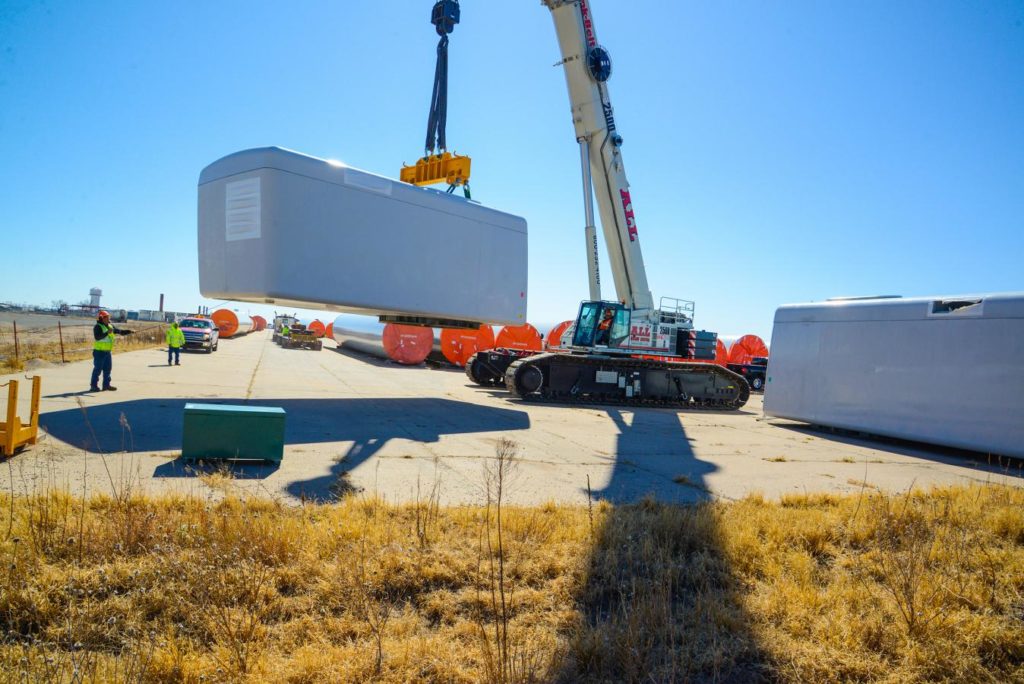Lexington, KY – A Link-Belt TCC-2500 250-ton (235-mt) telescopic crawler crane is on rent to R.J. Corman Railroad Services in Central Kansas. R.J. Corman Railroad Services is contracted by Watco Supply Chain Services to unload wind components delivered by truck and rail at two 30 acre sites in Great Bend and Larned, KS. “We have a couple of power lines we have to go under and with the TCC-2500 in Great Bend, it just makes it simple to suck in the boom, crawl under it, use one spotter, and get it done. With the lattice, you take your crew of men, a semi-trailer, lay the boom down to go under the power line, and we may have to do that two or three times a day,” said R.J. Corman Railroad Services Crane Operator, Patrick Nemec. Wind components are received via truck and rail, offloaded and placed on fixtures on the ground where they will remain for storage until they are assigned a wind farm for installation.
“We have a couple of power lines we have to go under and with the TCC-2500 in Great Bend, it just makes it simple to suck in the boom, crawl under it, use one spotter, and get it done. With the lattice, you take your crew of men, a semi-trailer, lay the boom down to go under the power line, and we may have to do that two or three times a day,” said R.J. Corman Railroad Services Crane Operator, Patrick Nemec. Wind components are received via truck and rail, offloaded and placed on fixtures on the ground where they will remain for storage until they are assigned a wind farm for installation.
By May 2018 over 1,000 wind components have delivered and have been stored between the two locations in 12 months.
 Components include everything from 44 – 57 m (144 – 187 ft.) blades (30,000 lbs.), hubs (68,000 lbs.), cans (120,000 lbs.), and machine heads (142,000 lbs.). The most recent crane addition to R.J. Corman Railroad Services’ stable of Link-Belts is the TCC-2500 that delivered on rent in November 2017 from ALL Family of Companies. R.J. Corman Railroad Services is also lifting with a 238 HSL lattice crawler crane, and two rough terrain six-wheel cranes, an RTC-80150 Series II and RTC-80100.
Components include everything from 44 – 57 m (144 – 187 ft.) blades (30,000 lbs.), hubs (68,000 lbs.), cans (120,000 lbs.), and machine heads (142,000 lbs.). The most recent crane addition to R.J. Corman Railroad Services’ stable of Link-Belts is the TCC-2500 that delivered on rent in November 2017 from ALL Family of Companies. R.J. Corman Railroad Services is also lifting with a 238 HSL lattice crawler crane, and two rough terrain six-wheel cranes, an RTC-80150 Series II and RTC-80100.
In Great Bend, Nemec and the rest of the R.J. Corman Railroad Services crew used the TCC-2500 to unload 142,000 lb. machine heads, the heaviest wind components being delivered. “With pick and carry, the 2500 performs excellently. We can swing these machine heads over the side, out front, over the rear – then walk it to where we need. It’s just a hoss. I don’t know how else to say it, it’s just great,” said Nemec.
As components deliver to the laydown yard, the TCC-2500 is positioned in proximity to each shipment, able to pick and carry to the appropriate storage position. “Instead of the RT having to reset, we can have the driver back in within our radius. We grab each load and then crawl the TCC-2500 to stack wherever. If we were using an RT, you’d have to be able to get the truck right where we need to be and you’d be resetting the crane, lifting, moving, and jumping these heads. It would take half a day to do all that. With the TCC-2500, we just get the truck somewhat close to the target area, pick it, and I walk it where we need it,” said Nemec.
Each site is ideal for wind turbine storage as they are both near developmental sites for future wind projects. Both locations are also accessible to two Class One railroads (BNSF and Union Pacfic) and Highway 56 for out-of-state component deliveries from Arkansas, Florida, and North Dakota.
Source: Link-Belt

